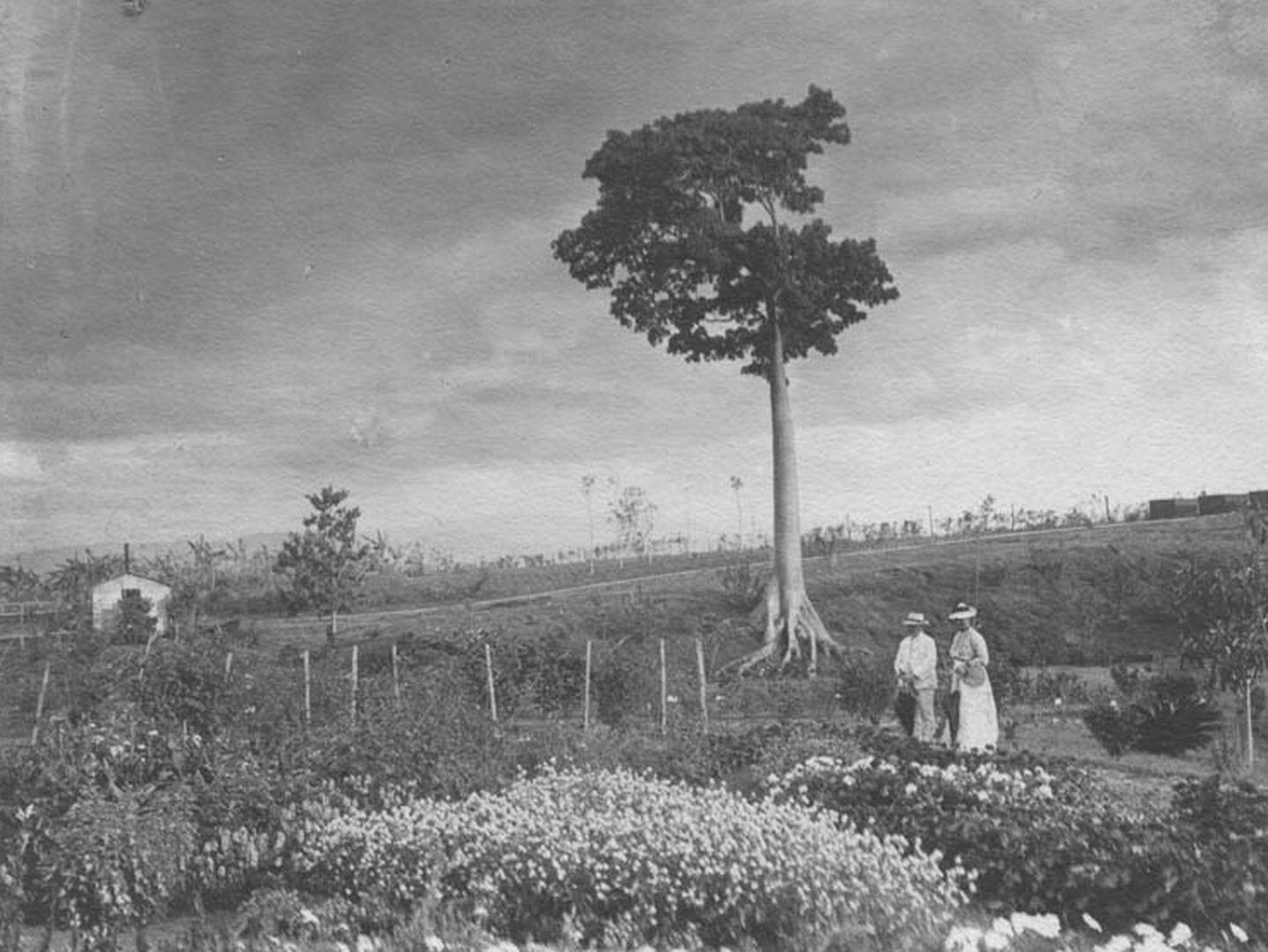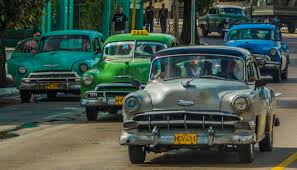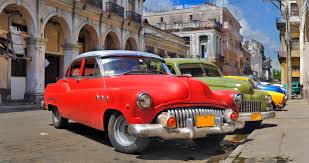
Llewellyn King: My Christmas in poor, beautiful Cuba
These Spanish Colonial era buildings are a common sight across Havana, along with old cars.
— Photo by Bryan Ledgar
There was much business done in Cuba by New England enterprises, especially in sugar but also in tobacco and fruit. Here’s the Soledad plantation of Belmont, Mass.-based sugar mogul Edward F. Atkins. In the late 19th Century, Atkins was a dominant force in the U.S.-Cuban sugar market. His firm, E. Atkins & Co., established sugarcane plantations along the southern coast of Cuba near the cities of Cienfuegos and Trinidad. From the 1840s through the 1920s, the Atkins family operated their sugar business on the island, seeing it through the abolition of slavery, Cuba's fight for independence from Spain, and the changing agricultural and industrial practices of sugar production.
The huge and Boston-based United Fruit Co. owned or leased many properties in Cuba.
I have had a hankering to go back to Cuba. I went there with other journalists on a trip organized by the Center for Strategic and International Studies in the 1980s; and again on a National Press Club trip in 2003.
Over Christmas I went back, just to Havana, that dowager city, and lost myself in the best of Cuba: its architecture, its food, its music and its people.
But around me were plenty of signs of the other Cuba, the Cuba which is in extremis — the Cuba which is driving its citizens to leave in record numbers.
In 2022, by some accounts, about 400,000 Cubans left for work and a new life wherever in the world they could find it. The Customs and Border Protection agency estimates that in a recent two-year period, 425,000 sought entry to the United States.
Many Americans are surprised to hear that you can travel easily to Cuba these days. The confusion arises as the law seems to say “no,” but the regulations posted by the Treasury Department say “yes.”
My wife and I went through a commercial Cuba travel service called Cuba Explorer. We didn’t want to go as journalists; we wanted to take a quiet look at Havana, not through the eyes of officialdom. We signed up and so did two friends, a retired doctor and his wife.
The tour company arranged our Cuban visa and the “Certificate of Legal Cuba Travel,” a U.S. requirement. All we did was buy our tickets on American Airlines, which operates daily service from Miami. Delta, Southwest and JetBlue and also fly to Havana from various cities.
Border formalities are no more difficult than they are going to any country — say, Mexico or the United Kingdom.
Havana — and some of the smaller colonial towns which I visited previously — is a delight. It is among the great “built cities” of the world, like Paris, Vienna and St. Petersburg. However, as Havana is compact, it is easily seen; it is the kind of place you feel you can get your arms around.
The grandeur of its colonial past, its wealth of another time, is everywhere. So is the poverty of today. Some streets are sad, indeed, with all the manifestations of poor countries: people picking over garbage, pedal carts, even bullock carts. There are few overweight people and while Cuban food is complex and sophisticated, I’m told that Cubans survive on rice and beans.
Cubans also queue. Jokingly, one Cuban told me, “When we see a line, we go and stand in it — must be something good and, like all good things here, in short supply.”
Food for those outside the dollar-driven tourist economy is a struggle, as are medicines and simple things, like a favorite shampoo or paper products of all kinds. For travelers, one of the pleasures of Havana is that you always get a cloth napkin, not of choice but of necessity. Our new, comfortable hotel ran out of toilet paper. The American obsession with carrying Kleenex came in handy.
The 1950s cars are as plentiful as ever, but many are reengineered with modern Japanese or Russian engines; some declare they are all original parts and use Cubans abroad to scavenge junk yards and send parts back in relatives’ luggage.
The sanctions, with small modifications, have lasted since 1962, and are the longest-ever in U.S. history — and they haven’t worked. They haven’t brought down the Communist Party, freed the press or made the life of Cubans any better. Instead, they have subtracted hope.
The embargo is a peculiar cross that Cuba alone bears, especially when you think of the many dictatorial regimes we tolerate and befriend.
The Hill reported that Mexican President Andres Manuel Lopez Obrador told President Biden in a phone call that he could help reduce migration in the region if he could loosen the sanctions on Cuba. It is hard to find a Cuban who wants to leave the island, but wouldn’t if he or she could.
After 20 years, I had hoped to find a more prosperous Cuba, but it hasn’t happened. The small areas of free enterprise allowed by the state have created little oligarchies. Taxi drivers and waiters make much more money than doctors and engineers. These professionals count among Cuba’s exports, its brain drain. On the upside, there are many private restaurants with a thriving food culture for those who can afford it.
The fault is the failed Cuban communist model, but the United States hasn’t helped. Graham Greene, the great British writer, who penned The Power and the Glory, about the Mexican Revolution — from 1910 to 1920 —pointed out that it failed without the aid of an American embargo.
I have felt, now for 40 years, that Cuba would throw off communism if we let it alone, and got rid of the embargo, which is more about U.S. politics than the politics of Cuba.
Meanwhile, do visit Cuba while you can. It is a treat for the eyes, the ears and the palate. You won’t regret it.
Llewellyn King is executive producer and host of White House Chronicle, on PBS. His email is llewellynking1@gmail.com, and he’s based in Rhode Island and Washington, D.C.
Cuba's lessons for New England's farms
A stretch in Massachusetts of the Connecticut River Valley, the most fertile and agriculturally productive area in New England.
Adapted from Robert Whitcomb's "Digital Diary'' column in GoLocal24.com
There’s been quite a revival of small-scale agriculture in New England in recent years, with the products grown alluring to the swelling numbers of “locavore’’ customers, many of whom buy the stuff at those proliferating outdoor markets open from spring to late fall or at the increasing number of stores, including supermarkets, that tout the local origin and “organic’’ nature of their food. Proving that something is “organic’’ can be daunting….
Cuba, of all places, may have some lessons for successful small-scale organicagriculture here. Since the collapse of the Soviet Union, in 1991, deprived the Cubans of cheap petroleum-based fertilizers and pesticides, the Cubans have movedto become very successful growers of food without these manmade chemicals. This movement has been further encouraged by some reforms that have replaced huge state-run farms with many small farms -- some in urban areas -- run by individuals.
The lack of chemical fertilizers and pesticides has led over the years to more sustainable and healthier agriculture on the island.
I was reminded of this the other day after reading a Boston Globe column headlined “Is Cuba the future of farming?’’ by Greg Watson, who’s a former Massachusetts Department of Agriculture commissioner. Mr. Watson, whom I know slightly, is no apologist for the Communist dictatorship led by the late Fidel Castro and now his brother Raul. But Mr. Watson has zeroed in on what the Cubans have been doing well.
Cuba is not the “future of farming’’ for the United States in general: The economics of the food industry means that huge agribusiness farms in the Midwest, the Plains States, California, Florida and some other places will continue for decades. But in New England, where topography and population density encourage much smaller farms, Cuba offers some lessons, even when considering that the Cubans, unlike New Englanders, can grow things outdoors year round.
Providence-based United Natural Foods Inc., an “organic’’ foods distributor, is a natural partner for such small-scale farms and the markets and restaurants they help supply. The company has just announced that it’s adding 150 new jobs in Rhode Island, where it already employs about 450 people.
Josh Fitzhugh: In Cuba, old U.S. cars as metaphor
Editor’s note: Insurance executive, lawyer, farmer, Vermont maple-syrup mogul and former editor and reporter John H. (Josh) Fitzhugh, sent us this piece the other day. By the way, New Englanders should be aware of the very long social, cultural and economic ties between Cuba and our region. The old Boston-based United Fruit Co. is just one example, not to mention the many New England firms that made candy, booze, molasses and brown and white sugar from Cuban sugar cane, some of it grown on farms with New England-based owners. And yes, the slave trade. My paternal grandparents and parents went down there a couple of times to enjoy the raffish activities under assorted pre-Castro dictators/gangsters.
-- Robert Whitcomb
xxx
I traveled with my daughter, Eliza, on a Dartmouth College-led tour thinking that I should “time travel” to see what Havana and the island were like now before tourism and American business interests transformed it.
I needn’t have rushed. While change is certainly underfoot in Cuba, I left the island after a week with the conviction that the tangled relationship between the U.S. and Cuba will take decades to sort out absent some leadership change as dramatic as occurred a half century ago.
First, a bit about the trip. As required by the rules of the U.S. embargo of Cuba, the trip was organized as a people-to-people exchange to enhance “contact with the Cuban people, support civil society, or promote the Cuban people’s independence from Cuban authorities.”
Dartmouth’s method for accomplishing these goals was to have us accompanied by a professor of Spanish; to organize numerous lectures by Cuban authorities; to visit various art and music venues; to eat predominately at small private restaurants called paladars; and to permit us to pepper our good-spirited and intelligent Cuban guide, Abell, with constant questions regarding the deficiencies of the vaunted Revolution. Over the course of the week we toured old and new Havana; Hemingway’s residence, Finca La Vigia; the towns of Cienfuegos and Trinidad; and places in between. To say that we were exhausted by the time we left would be an understatement.
We also all learned a lot, and by that I mean that we all struggled on a daily basis to reconcile our growing understanding of Cuba with opinions as to how American (or Cuban) policy should change to better the lives of the people of both nations. Now that may sound kind of arrogant (who are we to assume such responsibility?) but it was the truth. As an American you can’t travel in Cuba without feeling some responsibility for the ways things are, including the country’s turn toward socialism. And President Obama’s initiative to press for closer contacts with Cuba have given these thoughts greater immediacy.
Now as to some observations. It would appear that over the past 50 years, Cuba has made great strides in health care and education (provided free of charge to the population) but at a cost of economic stagnation and tremendous deterioration of its physical structures. The government is quick to lay the blame for the latter on the embargo but in my opinion it has less to do with that than with the socialist mentality that has discouraged enterprise and private investment of any kind.
A good example is the deterioration that has occurred in old Havana, the location of many beautiful European style structures. Before the Revolution, according to a tour member who had been there, Havana’s old structures, mainly of cement and stone, were in pretty good repair. Today, one in ten is missing a roof; one in five have no windows. Three a day collapse, we were told. The reason? While families are permitted to live in the structures, they are not responsible for their upkeep, which is the government’s responsibility, and whether by design or lack of funds, it has not done so. The picture above is a good example of this decline.
Today, the only structures in old Havana in good repair are tourist spots (such as government-owned hotels) or small paladars snd small hostels, owned by families which under current rules can tap into and keep some of the profits from the burgeoning tourist trade. Even major government centers, like the Museum of the Revolution, are shabby and decrepit. The Capitol building, designed to look like Washington’s, has been closed for three years (although that may tell more about Cuba’s one-party rule than its finances, frankly.)
Faced with the loss of its sugar daddy, the Soviet Union, Cuba in the mid-‘90s first went through a horrendous economic decline (they call it the “special period”) and then began to pull itself back with help from Chavez’s Venezuela and an increasing reliance on tourism. Today, China and Vietnam seem to have replaced Venezuela as major trading partners but tourism continues to grow, and with it major economic issues.
In short there now appear to be two economies in Cuba: the tourist economy, where taxi drivers, restaurant operators, hoteliers, tour operators, artists and musicians prosper; and the rest of the economy, which suffers along at $20 a month in government wages plus whatever black market income one can find. This income disparity is worsened by those lucky enough to have relatives overseas who send back “remittances,” and most of these are Cuban whites from formerly middle- and upper-middle-class families in Havana.
An example of this disparity was manifest in a dinner we had with some young artists. The young Afro-Cuban at our table has an art degree and has had some moderate success selling his work, mainly to tourists. He now supports his brother a dentist who is on the state payroll. Another example was a young man whose father was ambassador to Paris in the ‘70s. Trilingual in Spanish, French and English, he worked in a restaurant until three years ago, when he began driving his family’s original 1955 Chevy as a taxi in Havana because his income prospects were better.
The lack of investment is also apparent in the country. Cuba nationalized the hated sugar plantations and mills, but after a disastrous attempt to maximize sugar production in the 90s, has now cut back on sugar production in an effort to diversify agriculture and reduce food imports. Despite efforts to privatize small farms and urban gardens, however, a tremendous amount of land remains fallow, land that to my eye was probably cultivated before the Revolution. Coupled with the ongoing demographic flow from country to city and the lack of any environment for foreign investment, I don’t see much prospect for agricultural growth and believe Cuba’s goal of producing 70 percent of its own food a pipe dream.
In general we found the Cuban people well behaved, good humored and (as best as one can generalize such things) happy. They are proud of their independence and tolerant of their leaders. They seem willing to recognize mistakes and move on. While constantly reminded by their government that Uncle Sam is evil and untrustworthy, and that the socialist ideals of the Revolution should be venerated and followed, my sense is that most Cubans love American culture and take an attitude toward their government that “this too shall pass.” Many have become very adept at managing their immediate environment to try to benefit themselves and their families.
The prevalence of old Chevys, Fords, and Cadillacs is a kind of metaphor for this attitude, I think. Keeping these vehicles going is of course a necessity due to the U.S. embargo and a real testament to the mechanical ingenuity of Cubans, but since they are so obviously a symbol of America, and of Cuba before the Revolution, they also bespeak(to me at least) a kind of protest with the way things are and a hope as to what may eventually return. So is the practice of using the dollar sign ($) to denote an item’s cost in pesos.
Like a divorced couple, Cuba and America have much history to remember and to forget, but will forever be linked in some fashion by their proximity to one another.













